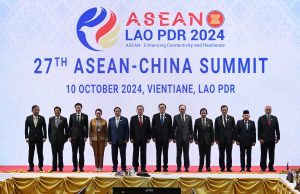Southeast Asia is vital for China. Well-known international relations scholar Yan Xuetong has stated that the region will develop economically, politically, and militarily in the future, surpassing other neighboring areas. But for the same reason, the United States aims to contain China by increasing its presence in the region. Thus, Southeast Asia is a key battleground in the rivalry between the U.S. and China.
In this context of superpower competition in Southeast Asia, the region has shown support for China’s strategic leadership in at least four significant areas.
First, Southeast Asia recognizes China as a provider of global public goods, particularly during critical times. During the COVID-19 pandemic, Southeast Asian countries received 29 percent of China’s total vaccine donations and 26 percent of its vaccine sales. Indonesia was the largest recipient, importing 61 percent of the total Chinese vaccines distributed in the region. In what is being referred to as a new Cold War, the outcome of the China-U.S. competition will not hinge solely on military strength; rather, it will be determined by which country can effectively and efficiently deliver global public goods.
Second, Southeast Asia endorses Beijing’s global vision. All ASEAN countries, except Singapore, have included the concept of a Community of Shared Future in their joint statements with China. In 2024, Southeast Asia emerged as the largest destination for Belt and Road Initiative (BRI) investments, accounting for 35.34 percent of the total. Notably, Indonesia was the leading recipient globally, attracting $9.3 billion in 2024.
Third, Southeast Asia has also supported China in its ambition to become a leader in technological standards by adopting Chinese technologies. Companies like Huawei have established a strong presence in Southeast Asia’s digital infrastructure, particularly in areas such as AI applications, telecommunications, and cloud computing. Moreover, China has become the largest partner in infrastructure financing for Southeast Asia, committing to 24 out of 34 (85 percent) megaprojects in the region.
Fourth, Southeast Asia supports China as the leader in the global supply chain, as outlined in the Made in China 2025 Initiative. This initiative focuses on ten strategic sectors, including electric vehicles (EVs) and rail transport. While countries in the West have expressed discomfort with China’s dominant position in these industries, Southeast Asia is not only happy to import Chinese-made products but eager to take part in these China-centered supply chains. Currently, China dominates the global EV market, sourcing 92 percent of its battery-grade nickel supply from Indonesia.
In addition to strengthening China’s strategic leadership, however, Southeast Asia also presents challenges for the country. Two cases in this region illustrate how China’s aspirations for leadership are confronted by obstacles from Southeast Asian nations.
The first case involves the South China Sea disputes. Most ASEAN states, particularly the Southeast Asian littoral states, have expressed support for the Philippine-initiated 2016 UNCLOS tribunal ruling that invalidated Beijing’s claim in the South China Sea. In contrast, China dismisses the ruling as null and void.
ASEAN is increasingly concerned about China’s actions in the disputed waters, which threaten the bloc’s unity on issues. For example, in 2012 China leveraged its influence over Cambodia, the ASEAN rotating chair for that year, to block a consensus on the South China Sea. This move ultimately resulted in the failure to produce a joint communiqué.
The second case involves China’s limited role in mediating the Cambodia-Thailand conflict. Given that Southeast Asia is a critical battleground for China-U.S. rivalry, both superpowers were eager to mediate the conflict to strengthen their influence. In contrast, during the 2011 Cambodia-Thailand conflict, neither the U.S. nor China participated in the peace process; the ceasefire was achieved with Indonesia’s mediation, as it held the ASEAN rotating chair. This instance showcased ASEAN’s ability to resolve internal issues independently, without the intervention of superpowers.
However, the Cambodia-Thailand clashes of 2025 attracted significant attention from both China and the United States. If China were to succeed in mediating the Cambodia-Thailand conflict, Beijing would likely tout this as a successful application of its Global Security Initiative, similar to its claims regarding the Saudi-Iran deals in March 2023. China repeatedly offered to mediate, but this proposal was met with skepticism in domestic Thai politics. Many Thai leaders are uncomfortable with China’s considerable influence over Cambodia and perceive it as the arms supplier to the Cambodian army, which contributed to the conflict.
Ultimately, the United States played a crucial role in finalizing the ceasefire agreement. Both parties agreed to the ceasefire after U.S. President Donald Trump pressured them, warning that the ongoing conflict would impede tariff negotiations. The ceasefire agreement was reached on July 28, 2025, with Malaysia serving as the ASEAN rotating chair and the United States co-organizing the talks, alongside active participation from China. This was stated in the Joint Press Release following the talks and the ASEAN Foreign Ministers’ Statement. Representatives from both the U.S. and China were also present at the meeting. Following the establishment of the ceasefire, Trump rewarded Cambodia, Thailand, and Malaysia with a tariff reduction to 19 percent.
In some ways, Southeast Asia significantly supports China’s strategic interests in regional and global leadership. Regional states have by and large accepted China’s vision for a Community of Shared Future and its role in the global supply chain. However, challenges remain, particularly regarding South China Sea issues and the perception of China’s role in disrupting ASEAN unity, as seen in the 2025 Cambodia-Thailand conflict. If China successfully addresses these challenges, it can better pursue its leadership aspirations in the region and beyond.





























